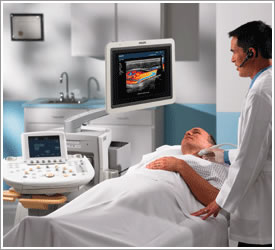Carotid Duplex
A carotid duplex is a noninvasive ultrasound test which allows physicians to evaluate the carotid arteries, the arteries that carry blood to the brain. Duplex ultrasound demonstrates how well blood is flowing through these vessels, the speed with which the blood is flowing and measures the diameter of the vessel walls to evaluate for any plaque buildup or obstruction that may be present.
 This test is performed in an outpatient setting by an ultrasound technologist, and there is no specific preparation involved.
This test is performed in an outpatient setting by an ultrasound technologist, and there is no specific preparation involved.
The test typically takes about 30 minutes and after the test is complete, you may immediately resume your normal activities. The results will be interpreted by a radiologist, and your referring physician will be made aware of those results.
Peripheral Vascular Ultrasounds
A peripheral ultrasound is a noninvasive test which allows physicians to evaluate the arteries and veins that carry blood throughout your body. Duplex ultrasound demonstrates how well blood is flowing through these vessels, the speed with which the blood is flowing, and measures the diameter of the vessel walls to evaluate for any obstruction, blood clot, or damage to the valves that may be present.
This test is performed in an outpatient setting by an ultrasound technologist and there is no specific preparation involved. During the test you will be positioned lying on a table or standing.
The test is painless and typically takes about 30 minutes and after the test is complete you may immediately resume your normal activities. The results will be interpreted by a radiologist and your referring physician will be made aware of those results.
Ankle Brachial Index (ABI)
An Ankle Brachial Index (ABI) is a test that measures the blood pressure in the arms, legs and feet. After these measurements are taken the ratio of the blood pressure in the lower legs to the blood pressure in the arms is calculated. This test is done in order to predict the severity of peripheral arterial disease (PAD) also known as peripheral vascular disease (PVD). The test may also be used to see how well a treatment or exercise program is working, especially if you have already undergone angioplasty or surgery.
This test is performed in an outpatient setting by a technologist. The technologist will place multiple different blood pressure cuffs on your arms, thighs and calves, as well as the big toes. The pressures will then be measured. Most patients report only minor discomfort from the pressure of the cuff during inflation. Once the test is completed an interventional radiologist will interpret the results and discuss them with your referring physician to determine if any further treatment is necessary.

